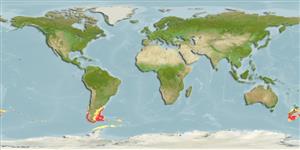Classificação / Names
Common names from other countries
Referência principal
Tamanho / Peso / Idade
Max length : 90.0 cm TL macho/indeterminado; (Ref. 1371); common length : 60.0 cm TL macho/indeterminado; (Ref. 1371); Peso máx. publicado: 850.00 g (Ref. 4883)
Length at first maturity
Lm ?, range 33 - 40 cm
Ambiente
; marinhas bentopelágico; oceanódromos (Ref. 51243); intervalo de profundidade 50 - 900 m (Ref. 27363), usually 200 - 400 m (Ref. 7061)
Clima / Intervalo
Temperate, preferred 9°C (Ref. 107945); 37°S - 65°S, 165°E - 34°W (Ref. 54589)
Distribuição
There are 2 disjunct populations. Micromesistius australis australis occurs around the Falkland Islands and Argentine Patagonia in the southwest Atlantic; off Chile in the southeast Pacific; also off South Georgia, South Shetland and South Orkney islands. Micromesistius australis pallidus occurs around the South Island of New Zealand.
Países | Áreas FAO | Ecossistemas | Ocorrências | Introduções
Descrição suscinta
Espinhos dorsais (total): 0; Raios dorsais (total): 43-55; Espinhos anais 0; Raios anais : 56 - 71; Vértebras: 54 - 57
Status na Lista Vermelha da IUCN (Ref. 115185)
Perigo para os humanos
Harmless
Uso pelos humanos
Pescarias: altamente comercial
Ferramentas
Relatórios especiais
Baixar XML
Fontes da internet
Estimates of some properties based on models
Phylogenetic diversity index
PD50 = 0.7500 many relatives (e.g. carps) 0.5 - 2.0 few relatives (e.g. lungfishes)
Nível Trófico
3.3 ±0.48 se; Based on food items.
Resiliência
Médio, tempo mínimo de duplicação da população 1,4 - 4,4 anos (K=0.18; tm=2-5; tmax=30)
Vulnerabilidade
Moderate to high vulnerability (52 of 100)
Categoria de preço
